
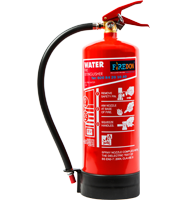
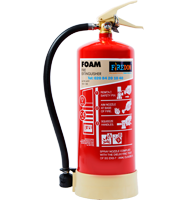
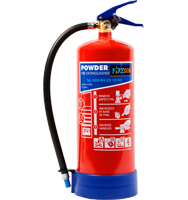
For Class A, B, C & E Fire Risks
Operated by Stored Pressured
Read More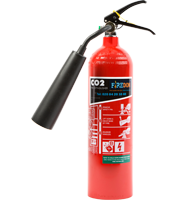
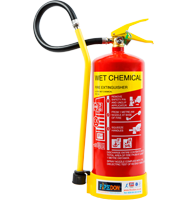
You need to act instantly and swiftly making sure you stay calm once you become aware of a fire.
Alert Everyone and Raise The Alarm
Make sure everyone on your premises knows about the fire. Raise an ALARM if there is one or Shout 'FIRE' 'FIRE' 'FIRE'
Don't Delay
You can't afford to waste any time. Don't stop to investigate the fire. Under no circumstances should you go looking for your belongings or valuables.
Shut Doors
As you go out, only open the doors you need to. Close any open doors and windows. Before you open a door, check it with the back of your hand. If it's warm, don't open it - the fire is on the other side of the door.
Get everyone out
Use your escape route; try staying together if you can.
Crawl on the floor if there's smoke
The air is cleaner near the floor so if there's smoke, get on your knees and crawl out following the fire exit signs. Remember, smoke is poisonous and can kill you.
Dial 999
Once you've escaped, use a mobile, a neighbour's phone or a phone box. 999 calls are free
Don't call the local fire station's number- it will probably take longer to be answered.
Speak slowly & clearly. Give the whole address of your premises, including the town. Say what is on fire (e.g., two-storey house or three-storey shop and flats).
Explain if anyone is trapped and what room they are in if you know. The more information the Fire & Rescue Service has, the quicker it can get to you and act when it gets there.
Don't go back inside
Don't go back inside for anything. If there's someone still inside, wait for the Fire & Rescue to arrive, you can tell them about the person and they will be able to find them quicker than you. If you disappear inside the building that will slow down the fire-fighter's efforts to rescue anyone else missing, apart from putting your life in great danger.
Wait at the assembly Point if one is allocated or far away, safe from the building
Find somewhere safe to wait, i.e. "FIRE ASSEMBLY POINT". When the Fire & Rescue Service arrives, give them as much information as possible about the fire and the building.
When the fire is between you and your escape route, you have to react in a different way.
Use a Fire Extinguisher
You can use the right type of fire extinguisher if you know which & how to use one to get yourself out of the building, if not then don't use the wrong type as you may put your life as well as others in danger, making the fire worse.
Get out of a Window
You may be able to escape through a window if you are on the ground floor or the first floor. If you're on the first floor, you should only do this as a last resort - when you are in immediate danger.
Cushion Your Fall
Throw bedding, cushions, etc, onto the ground to break your fall.
Don't Jump
Lower yourself by your arms from the window ledge before dropping.
Lower Children
If there are two adults, one should go down first to catch the children. The other should lower the children as far as possible before letting them drop.
If you have to break the window
Use a heavy object to hit the glass at the bottom corner. Make the jagged edges safe with a towel or blanket, or any soft material to protect you from getting cuts during the escape, making sure you do not narrow the escape route.
When your escape route is blocked and you can't use a window, you need to keep safe in the building.
Get everyone into one room
Choose a room with a window and a phone if possible. Shut the door.
Block the door
Put cushions, bedding, clothes, etc. round the bottom of the door to block the smoke getting in to the room.
Open the window and call for help try getting someone attention
It's important to let the fire-fighters know you are there, and if you haven't managed to call 999 you need to raise the alarm and shout for help till you obtain someone's attention.
Stay by the window
Lean out of the window to breathe if you need to. Keep drawing attention to yourself.
Don't run around
You'll only fan the flames and make them burn faster so don't run around and stay calm.
Lie Down
This makes it harder for the fire to spread. It also reduces the effect of flames on your face & head (flames burn upwards).
Smother the Flames
Cover the flames with heavy material, like a coat or blanket. This blocks the fire's supply for oxygen.
Roll Around
Rolling smothers the flames. Remember - STOP! DROP! ROLL!
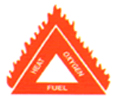 There are three essentials to every fire. There must be:
There are three essentials to every fire. There must be:
(There are exceptions to this rule, but these are fre and highly specialised in character.)
The process of combusition can be linked to a triangle whose side are.
 The three principle methods of extinguishing fires (i.e. the removal of one side of the "triangle of combustion") are:
The three principle methods of extinguishing fires (i.e. the removal of one side of the "triangle of combustion") are:
Starving is sometimes preferred, but it is seldom a practicable method.
Something and cooling are the methods commonly used.
| Categories | Type | Fire Caused By |
|---|---|---|
|
|
Solids | Combustion of solid materials of organic origin, which normally burn under production of embers, e.g., wood, paper, straw, textiles, coal, etc. |
|
|
Liquid | Combustion of liquids or materials that liquefy, e.g., petrol, fats, oils, paints, ether, paraffin, etc. |
|
|
Gas | Combustion of gases e.g., methane, propane, hydrogen, acetylene, gas, etc. |
|
|
Metal | Combustion of metals e.g., magnesium, lithium, sodium, potassium and their alloys etc. |
|
|
Electric | All fires that are complicated by the presence of live electrical equipment or wiring. |
|
|
Cooking Oil | Combustion of cooking oil and fat. |
| Types of Extinguishers |
|
|
|
|
|
|
|---|---|---|---|---|---|---|
| Water (W) |
|
|||||
| Foam (AFFF) |
|
|
||||
| ABC Powder (DP) |
|
|
|
|
||
| Carbon Dioxide (CO2) |
|
|
||||
| Wet Chemical (WC) |
|
|